Hip Dysplasia in Dogs

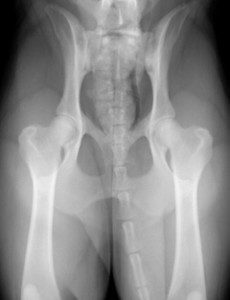
X-ray of normal hips.
Osteoarthritis is one of the most common diseases of dogs, affecting up to 25% of all dogs during their lifetime. Hip and knee osteoarthritis are the most common locations but have dramatically different causes and treatments.
The majority of osteoarthritis of the hip is due to hip dysplasia. This disease results from genetics which leads to poor hip conformation, laxity, and subluxation (loose joints) while the dog is young. As the dog ages, the joints actually tighten up, but the resulting poor fit of the joint (incongruence) leads to the grinding of cartilage and inflammation of the joint. Many adult dogs with severe hip dysplasia and osteoarthritis have no normal cartilage remaining in their hip joint.
Exercise intolerance is the most common; fewer dogs actually limp with hip dysplasia.
One of the most common signs of hip dysplasia in young dogs is “bunny hopping,” where the dog uses both hind limbs simultaneously.
Medical Management
Medical management of hip dysplasia includes 5 treatment principles:
- Management of body weight
- Nutritional supplementation
- Moderation of exercise
- Physical therapy
- Medications
Surgery
THERE ARE SEVERAL SURGICAL OPTIONS FOR THE YOUNGER DOG WITH HIP DYSPLASIA. THEY ARE:
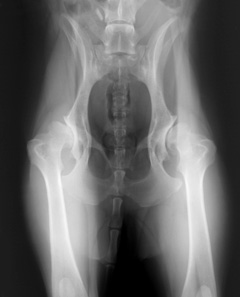
X-ray of arthritic hips from hip dysplasia.
- juvenile pubic symphodesis (JPS)
- triple pelvic osteotomy (TPO)
- femoral head and neck ostectomy (FHO)
- total hip replacement (THR)
JPS
JPS is a technique of correcting the anatomy of the pelvis in a dog that is still growing. This relatively simple technique changes the anatomy of the pelvis by changing the rate of growth at one of the growth centers. This procedure is only effective in puppies under 20 weeks of age. In JPS an electroscalpel is used to slow the growth of the pelvis at the pubic symphysis.
Triple Pelvic Osteotomy
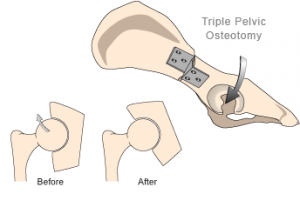
Triple pelvic osteotomy has the same effect as JPS in increasing the coverage of the socket of the pelvis over the ball of the femur. In this procedure, the pelvis is cut and rotated because the skeleton is or is nearly completely grown. Triple pelvic osteotomy is a common and safe procedure that is usually very well tolerated by dogs. In most cases, they are walking on the operated leg immediately after surgery.
FHO
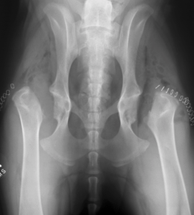
Radiograph (x-ray) following bilateral FHO’s.
FHO is an excellent option for small dogs (and cats). In this surgery, the ball of the ball and socket joint is removed. The hip then works by having the leg supported by the gluteal muscles. Because of their small body weight, small dogs and cats tolerate this procedure very well. In larger dogs, the outcome is not always as good. Ultimately the outcome of this procedure is unpredictable but is probably improved by combining the procedure with professional physical therapy.
THR
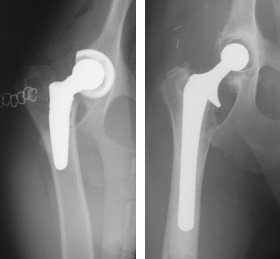
Cementless (left) and cemented (right) total hip replacements.
Total hip replacement surgery has been performed in thousands of dogs in the US and the world. The outcome is generally excellent in 85% to 90% of dogs; however, when complications occur, they can be frustrating and expensive. Traditionally THR was always performed as late in life as possible because of concern for the implants wearing out.